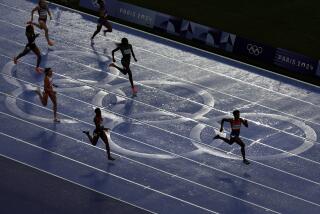She can do that
- Share via
Think X Games and testosterone immediately comes to mind. The world of extreme sports is a world dominated by boys -- boys racing over the edges of vert ramps on skateboards; boys performing airborne acrobatics on dirt bikes; boys skimming fast-moving waves on surfboards.
Or so it seems.
There are a lot of girls too, but they don’t get nearly as much attention. Take aggressive in-line skater Fabiola da Silva. With six golds to her credit, she’s the most medaled female athlete at the X Games, taking place for the ninth time this weekend at L.A.’s Staples Center. She’s also the only girl to compete against boys in any X Games sport -- aggressive in-line vert -- yet few people outside of the extreme sports world even know her name.
Does Da Silva care? No. The 24-year-old Brazilian is gender blind.
“A lot of girls think girls aren’t good enough to be skating against the guys,” she explained in English with a slight Brazilian accent. “I just think different. If I see a guy doing it, I think it’s possible for a woman to do it also. Why not?”
Known to fans as “Fabby,” Da Silva packs a lot of punch into her 5-foot-2-inch, 112-pound frame. She has a reputation for skating harder, faster and more fearlessly than any of her female peers, so much so that in 2002 the Aggressive Skaters Assn. discontinued its women’s vert competitions because “there was just no depth of talent beyond Fabiola,” said ASA Executive Director Todd Shays.
“She’s strong, she’s gutsy and she’s willing to try,” he said. “You have to really have guts on the half pipe because if you fall, it’s a long way down.”
How far down? About 18 feet if you glide up to the top of a 13-foot half pipe, then catch 5 feet of air over its edge to do a major trick.
Da Silva has, unfortunately, been there. One week before last year’s X Games she lost her footing while grinding the undersides of her skates along the top of the ramp. She flipped over and landed on the flat bottom, twisting her knee so badly she needed arthroscopic surgery.
Such an accident might have stopped a lesser skater, but not Da Silva.
In preparation for this year’s games, she’s been working out for two hours, then skating an additional four or five hours each day. The only female in a field of 35, she’s expected to place in the top 10 this weekend.
Between 1996, when she first started competing in the X Games, and 2001, the last year there was a vert division for women, Da Silva placed first every year except 1999, when she was defeated by Japanese skater Ayumi Kawasaki and placed second.
“Fabiola progressed enormously early on in her career, and then kind of stagnated when there was a separate women’s division and there was no one pushing her. She was just winning,” said Shays. “It was exciting in 2002 when we combined the men and women to see her level shoot up again. She was skating with and against skaters who are much better than her, and it pushed her to excel.”
Da Silva has been in-line skating for a decade, beginning in Sao Paolo, Brazil, where she was born. At age 12, she started skateboarding just to have fun with her friends, “but then I saw some guys roller-blading.”
Her interest was piqued. She dug out the pair of roller skates she had at home to try it out, decided she liked it and quickly made the move to Rollerblades. Five years ago she moved to California. She now lives in Santa Ana.
“It’s closer to the skate parks,” she said. In her native Brazil, Da Silva skated only on the street, but “when I moved to America everybody was doing everything, so I started skating everything,” she said. “I think it helps you to become a better skater.”
These days Da Silva still skates street. In this weekend’s aggressive in-line street competition, which still has a women’s field, she’s expected to medal. But she excels in vert because it’s her passion.
“It feels so good to be able to skate big ramps,” she said.
Of the events showcased at the X Games, aggressive in-line skating may not be as well known as skateboarding or BMX biking, but it’s a sport that continues to grow in popularity. The National Sporting Goods Assn. estimates there are 28 million in-line skaters internationally, with aggressive skating the fastest-growing segment of the market.
Like mountain boarding, sand boarding and other up-and-coming extreme sports, aggressive in-line skating is heavily influenced by skateboarding. It surfaced in the early ‘80s, when in-line skates, formerly an off-season training device for hockey players, crossed over to the general public as Rollerblades.
It was 1981 when a handful of bladers started riding their in-line skates on the same terrain as skateboarders, performing copycat tricks on rails and ramps.
Not surprisingly, the Rollerblade brand has a lock on the aggressive in-line skate market. It is also one of the handful of sponsors that allow Da Silva to do her thing full time.
“The reason I am in the U.S.A. is for skating,” she said. “Roller-blading is my life.”
*
X Games
What: Aggressive In-Line Skating
Where: Staples Center, 1111 S. Figueroa St., L.A. Other events at other area venues.
When: Thursday, 1:30-4 p.m., Aggressive In-Line Men’s and Women’s Park Final. Saturday, 11 a.m.-1:30 p.m., Aggressive In-Line Vert Prelims. Sunday, 1:30-2:30 p.m. Aggressive In-Line Vert Final.
Cost: $5 per person, per day at that venue at www.ticketmaster.com.
Info: www.espn.com.
More to Read
Go beyond the scoreboard
Get the latest on L.A.'s teams in the daily Sports Report newsletter.
You may occasionally receive promotional content from the Los Angeles Times.






